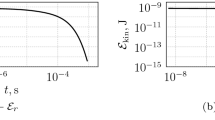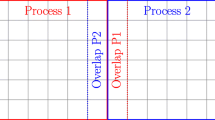Abstract
This article is devoted to the development and application of the filling cells method for the solution of hydrodynamics problems with a complicated geometry of the computational domain, in particular, a liquid domain, to increase the smoothness and accuracy of the finite-difference solution. The spatial-two-dimensional flow problem of a viscous fluid between two coaxial semicylinders and the spatial-three-dimensional problem of wave propagation in the coastal zone demonstrate the possibilities of the proposed method. The rectangular grids are used to solve these problems, taking into account the filling of cells. The approximation of problems are used to split schemes in time for physical processes and the approximation in spatial variables is made using the balance method, taking into account the filling of cells and without it. An analytical solution describing the Taylor-Couette flow is used as the reference to assess the accuracy of the numerical solution of the first problem. The simulation is performed on a a sequence of condensing computational grids with the following dimensions: 11 × 21, 21 × 41, 41 × 81, and 81 × 161 nodes in the case of using the method and without using it. In the case of the direct use of rectangular grids (stepwise approximation of boundaries), the relative error of the calculations reaches 70%; under the same conditions, the use of the proposed method allows us to reduce the error to 6%. It is shown that splitting up the rectangular grid by factors of 2 to 8 in each of the spatial directions does not lead to the same increase in the accuracy of the numerical solutions obtained taking into account the filling of the cells.












Similar content being viewed by others
REFERENCES
A. I. Sukhinov, A. E. Chistyakov, E. F. Timofeeva, and A. V. Shishenya, “Mathematical model for calculating coastal wave processes,” Math. Models Comput. Simul. 5, 122–129 (2013). https://doi.org/10.1134/S2070048213020087
A. I. Sukhinov and A. A. Sukhinov, “Reconstruction of 2001 ecological disaster in the azov sea on the basis of precise hydrophysics models,” in Parallel Computational Fluid Dynamics 2004: Multidisciplinary Applications (2005), pp. 231–238. https://doi.org/10.1016/B978-044452024-1/50030-0
A. V. Nikitina, M. V. Puchkin, I. S. Semenov, A. I. Sukhinov, G. A. Ugolnitskii, A. B. Usov, and A. E. Chistiakov, “Differential-game model for the prevention of kills in shallow water bodies,” Upravl. Bol’sh. Sist. 55, 343–361 (2015).
A. I. Sukhinov, A. E. Chistyakov, and E. V. Alekseenko, “Numerical realization of the three-dimensional model of hydrodynamics for shallow water basins on a high-performance system,” Math. Models Comput. Simul. 3, 562–574 (2011).
A. S. Monin, “Turbulence and microstructure in the ocean,” Phys. Usp. 16, 121–131 (1973).
Yu. I. Shokin, Computational Experiment in the Tsunami Problem, Ed. by Yu. I. Shokin, L. B. Chubarov, An. G. Marchuk, and K. V. Simonov (Nauka, Novosibirsk, 1989) [in Russian].
B. N. Chetverushkin and M. V. Yakobovskiy, “Numerical algorithms and architecture of HPC systems,” KIAM Preprint No. 52 (Keldysh Inst. Appl. Math., Moscow, 2018).
L. D. Landau and E. M. Lifshitz, Course of Theoretical Physics, Vol. 6: Fluid Mechanics (Nauka, Moscow, 1986; Pergamon, New York, 1987).
M. M. Krasnov, P. A. Kuchugov, M. E. Ladonkina, and V. F. Tishkin, “Discontinuous Galerkin method on three-dimensional tetrahedral grids: using the operator programming method,” Math. Models Comput. Simul. 9, 529–543 (2017).
O. Yu. Milyukova and V. F. Tishkin, “A multigrid method for a heat equation with discontinuous coefficients with a special choice of grids,” Math. Models Comput. Simul. 8, 118–128 (2016).
V. A. Gasilov, I. V. Gasilova, L. V. Klochkova, Yu. A. Poveshchenko, and V. F. Tishkin, “Difference schemes based on the support operator method for fluids dynamics problems in a collector containing gas hydrates,” Comput. Math. Math. Phys. 55, 1310–1323 (2015).
O. M. Belotserkovskiy, Turbulence: New Approaches (Nauka, Moscow, 2003) [in Russian].
O. M. Belotserkovskii, V. A. Gushchin, and V. V. Shchennikov, “Use of the splitting method to solve problems of the dynamics of a viscous incompressible fluid USSR,” Comput. Math. Math. Phys. 15, 190–200 (1975).
O. M. Belotserkovskiy, V. A. Gushchin, and V. N. Kon’shin, “The splitting method for investigating flows of a stratified liquid with a free surface,” USSR Comput. Math. Math. Phys. 27, 181–191 (1987).
A. I. Sukhinov, A. E. Chistyakov, and N. A. Fomenko, “Methods of construction difference scheme for problems of diffusion=convection-reaction, takes into the degree filling of the control volume,” Izv. YUFU, Tekh. Nauki, No. 4 (141), 87–98 (2013).
A. A. Samarskii, The Theory of Difference Schemes (Nauka, Moscow, 1989; Marcel Dekker, New York, Basel, 2001).
A. A. Samarskiy and P. N. Vabishchevich, Numerical Methods for Solving Convection-Diffusion Problems (Editorial URSS, Moscow, 1999) [in Russian].
A. A. Samarskiy and E. S. Nikolayev, Methods for Solving Grid Equations (Nauka, Moscow, 1978) [in Russian].
A. I. Sukhinov and A. E. Chistyakov, “Adaptive modified alternating triangular iterative method for solving grid equations with a NonSelfAdjoint operator,” Math. Models Comput. Simul. 4, 398–409 (2012).
S. V. Vallander, Lectures on Hydroaeromechanics, The Handbook (LGU, Leningrad, 1978) [in Russian].
I. S. Menshov and M. A. Kornev, “Free boundary method for numerical solving gas dynamics equations in domains with varying geometry,” Math. Models Comput. Simul. 26, 612–621 (2014).
A. E. Lutsky, I. S. Menshov, and Ya. V. Khankhasaeva, “Numerical simulation of the wake influence on the flow around truncated cone,” Math. Models Comput. Simul. 9, 92–100 (2017).
Funding
The study was supported by the Russian Science Foundation (project no. 17–11–01286).
Author information
Authors and Affiliations
Corresponding authors
Rights and permissions
About this article
Cite this article
Sukhinov, A.I., Chistyakov, A.E., Protsenko, E.A. et al. Accounting Method of Filling Cells for the Solution of Hydrodynamics Problems with a Complex Geometry of the Computational Domain. Math Models Comput Simul 12, 232–245 (2020). https://doi.org/10.1134/S2070048220020155
Received:
Revised:
Accepted:
Published:
Issue Date:
DOI: https://doi.org/10.1134/S2070048220020155




